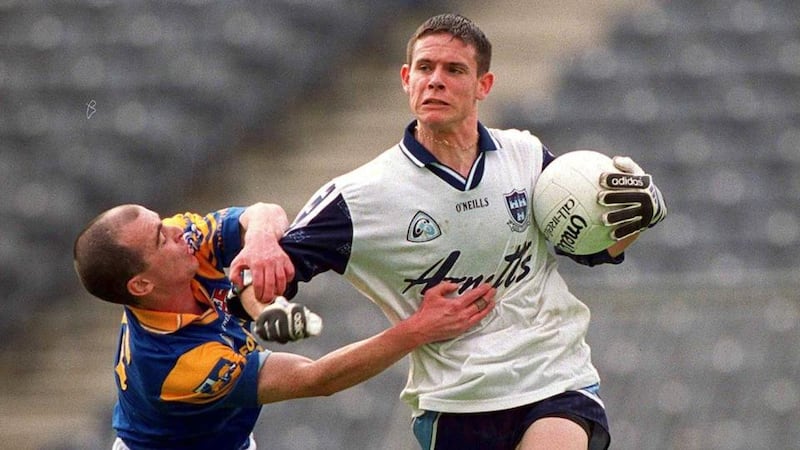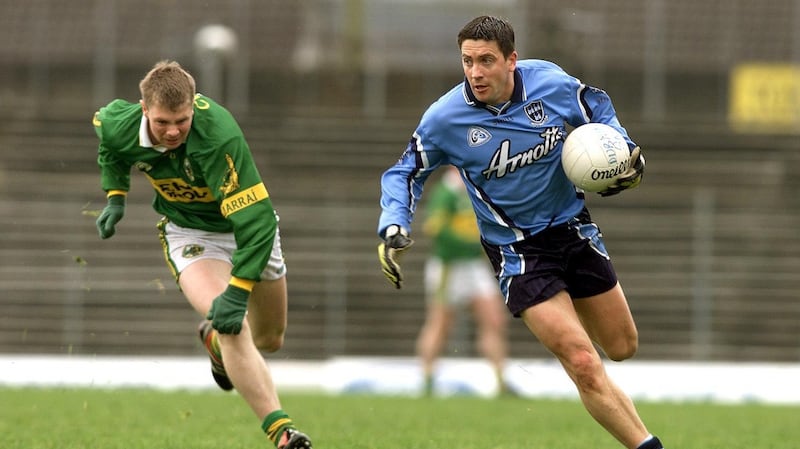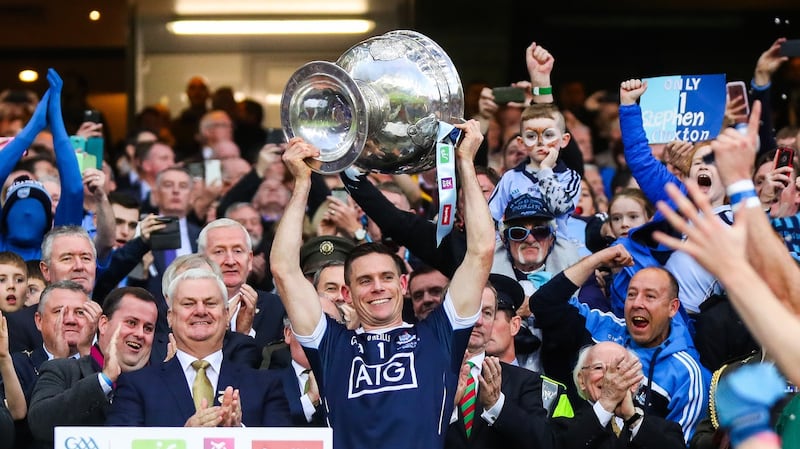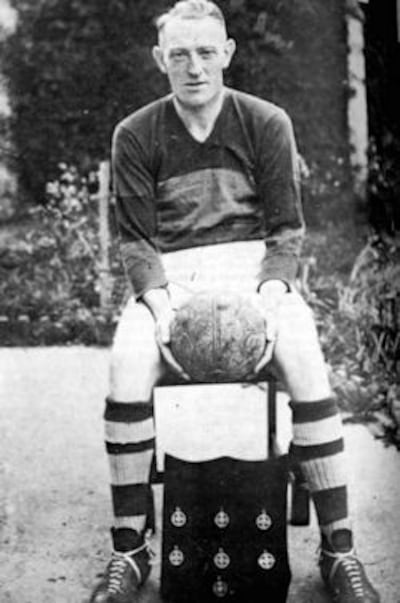It all feels so Jurassic now. On the day before Stephen Cluxton made his first cracks on the inside of the eggshell, the Irish Independent ran a small, two-column panel in the middle of its Saturday GAA spread. The date was May 27th, 2001. Dawn was about to rise across the hillside and daylight needed a user manual.
"With the Bank of Ireland football 'back door' due to open next Saturday week," ran the piece, "there is still a degree of confusion about its format. Many fans seem to think that only first-round losers will get a second chance, which is not the case. Every losing county, up to and including the beaten provincial finalists, will get a second chance."
Imagine. Sitting here in 2017, it feels a bit like describing air. The qualifiers became a fact of life from that weekend on, the wallpaper in every room of the GAA summer. In his own way, Cluxton did the same. On Saturday, he makes his 89th senior championship appearance in a Dublin jersey, outstripping all Gaelic footballers who ever laced a boot before him.
His debut was against Longford. He played championship before ever getting a run in the league, drafted in as cover for the injured Davy Byrne on the back of a decent, if ultimately fruitless, campaign with the Dublin under-21s that spring.

The young Dubs had coughed up the final to Meath back in April but Cluxton had kept three clean sheets along the way and got the nod in Byrne’s absence. Per some accounts, he got it over selector John O’Leary, by then five years retired and himself the holder of the all-time appearances record.
If the call-up was eye-catching, the lack of silverware for the under-21s was anything but. None of the previous 17 campaigns had yielded a Leinster title – no good reason why this one should have stopped the rot. Their minors had won just two out of the previous 12 Leinster titles and had no All-Ireland since 1984. Dublin clubs had won three of the previous nine Leinster titles and Kilmacud's 1995 All-Ireland was the only one to go to the capital since the '70s. That's just how things went in Dublin football at the time.
"Trying to explain to people now what it was like back then is hard," says Mick O'Keeffe, then a Dublin panellist. "But the people who were involved remember it very well. If you want a good reason why Dublin are so relentless now, look at the names of the guys who are involved. Jim Gavin, Dessie Farrell, Declan Darcy. Go back one step and you have Pat Gilroy. Apart from John Costello, these are the most influential people in Dublin football over the past decade.
“And the thing they all have in common is the fact that they lived through those barren years at the end of the ’90s and start of the 2000s and they don’t want Dublin going back to it. I think they have this nightmarish memory of what it was like to be a Dublin footballer in those days. Years of hope and no success. I think there are scars there for those guys and it has driven this generation of success. The players now know nothing but success but the guys behind it most certainly know what it was like.”
So let’s go back. In 2001, Seán Boylan was still over Meath, Mick O’Dwyer was still with Kildare, Páidí Ó Sé was still with Kerry, John O’Mahony still in charge of Galway. All four were considered well ahead of Dublin in the pecking order. Armagh had run Kerry to a replay in the previous year’s All-Ireland semi-final, Cork had been in a final just a couple of years previously too.
You’d have put Dublin comfortably in the top seven or eight but any suggestion of the top five would have had you laughed off your stool. They hadn’t won a Leinster title since 1995, exiting at the sight of whichever of Meath or Kildare they’d run into first each summer since their All-Ireland. They hadn’t won a league since 1993, they’d only been to one final. They were the England football team – plenty of noise but in all honesty, nothing for the serious teams to fear.
The Dubs were different then. The game was different too. Senan Connell was smack in the middle of his county career at the time, a fixture at wing forward. The distance between being a number 12 then and number 12 now can be measured in light years.
“Your tactics were based on the gladiatorial one-on-one duel in those days,” says Connell. “Their best forward being marked by our best defender and onwards from that. There was a flipchart team-talk on a Saturday morning with the two teams lined out and who was marking who. The whole overriding idea was structure.
"I played as a half forward and if I got stuck back the park, the roar that came your way was, 'get back in shape!' I would be marking Paul Curran in training and you'd have to tag him when he made a break forward but if I ended up spending a few seconds more than I was supposed to in defence, I got chased away back up to my position."

Even though Cluxton was his goalkeeper for over half of his career, Connell was a few years retired before the game got completely fixated on possession. He played out the best part of a decade in the Dublin jersey and can safely say he never once put his hand in the air looking for a kick-out, for instance.
“Never! Never, never, never, never. The job was, if you were a wing forward, get in around the breaks. That was what we said over and over and over again. Get in around your two midfielders and if that ball broke, you were on it. One of our key objectives going into games was for the middle six to win the battle on the ground. The two midfielders did their own job and we did the cleaning up underneath them.
“But the idea of going looking for a kick-out on your own? No chance. The roar in every dressing-room was always, ‘Lads, we’re not winning enough breaking ball!’ When do you ever hear a manager refer to breaking ball anymore at intercounty level? That’s only just over a decade ago and it feels like it’s nearly a primitive thing to be saying now. It’s all about possession restarts these days. Does Ciarán Kilkenny even know what breaking ball is?”
The game changed, the players changed. One caused the other, which caused the other, which caused the other, ad infinitum. Tom Carr had recently brought in Liam Hennessy to change up their fitness training. In those days, the league started before Christmas and the slog started before that and it felt like it never ended. But that was changing too.
A fella pulled up beside me in the car and saw me in the tracksuit and shouted out the window to ask if I had a match that day. Like, it was a Leinster final!
“I remember clearly the first night Liam Hennessy gave us a demonstration of engaging your core,” says Connell. “This was alien to everybody. Up to then, training was running, running and more running. You didn’t see a ball. The joke back then was that we were the best cross-country running team Dublin had ever seen.
“So Liam was coming in and telling us this was all changing and core work was going to be a big part of where we were going. He gave us this presentation down in the Army headquarters. And we were all looking at each other going, ‘What is this craic at all?’ But once he said that the long running was gone, we were more than happy to give whatever he had in mind a go.
“But even though it was ahead of its time, we were still doing things that you’d never dream of doing now. We did a weights session before we went out on the pitch every Tuesday and Thursday night. That included your squats, everything to build up your muscle. But can you imagine doing a heavy session of that before going out training with the ball these days?”
The outside world was changing too. Dublin already had the best sponsorship deal in the country, with Arnott’s backing them to the tune of a reputed £250,000 a year. But this was 2001 and the commercial world was really only starting to sniff around the sport. The dam sprouting leaks here and there; naturally enough it would be Dublin that were best placed when it burst.
“The turning point for sponsorship in Ireland was around that time,” says O’Keeffe, now the CEO of Teneo PSG and whose post-Dublin career has been spent in the nexus of sport and commercial hook-ups. “Within a couple of years, the GAA went to multi-sponsor deals. The professionalisation of Irish rugby, naming rights for stadiums, all that stuff was coming in and rolling out over the next few years.
“And if any team in the GAA was going to surf that wave, the Dublin footballers were always going to be the one. It wasn’t that the GAA commercialised everything, it was that Dublin got good just as sport was being commercialised in Ireland. What we see now is 10 to 15 years of that trend growing and growing and Dublin being major players in it. That’s the context of it all.”
As of last December, the Dublin County Board balance sheet shows a surplus of €490,000. The year Cluxton joined the panel, that surplus stood at £45,704 – around €58,000. Last year, Dublin’s various sponsorship deals were worth €1.5million to them, up from €1.19million the previous year. Stratospheric compared to the Arnott’s deal at the turn of the century.
“The last thing on a Dublin GAA player’s mind in 2001 was a sponsorship gig or any sort of PR event or anything like it,” says O’Keeffe. “From a commercial perspective, the GAA was coming out of the desert in those days really.
“Back then, playing for Dublin meant you probably got a bit of expenses if you were lucky. You got tickets. You got gear. And if you went into Arnott’s every now and then, if you asked for the right guy, you might get a discount on a pair of jeans. That’s not over-egging it, that’s what it was.
“Now, when Dublin won in ’95, a couple of lads would have benefitted commercially and Dublin would have looked after some lads in terms of jobs and coaching roles and whatever else. But really, that was it. There were no bells and whistles or fanfare to being a Dublin footballer around that time.
“I remember the day of a Leinster final, I was walking down the road in our housing estate in Booterstown in my Dublin tracksuit, heading to meet up with the team. Booterstown mightn’t have been a massive GAA area, fair enough, but still would be close to Kilmacud Crokes. And a fella pulled up beside me in the car and saw me in the tracksuit and shouted out the window to ask if I had a match that day. Like, it was a Leinster final!
“But that was what it was back then. Commercially, being a Dublin footballer didn’t mean a whole pile to anyone. There weren’t sponsored cars or anything. You got fed after training alright – it wasn’t like we were eating out of bins or anything. But it was nothing like what it would be now.”

One year folded into the next and Dublin teams got better as they went. The money came and the work went in. Costello revolutionised the underage set-ups across the capital and the clubs grew and grew. The GAA got sexier year by year and their rights deal with TV moved beyond just RTÉ.
Sitting here in 2017, it’s 11 years since Cluxton played a championship game that wasn’t live on television. Dublin’s under-21s have won seven of the last nine Leinster titles, including the last four in a row. Their minors have five of the last nine Leinsters, their clubs eight of the last 10, including the last five in a row.
The county’s emasculation of Leinster football is total and you can debate night and day over whether they will do the same to the game in general. But certainly nobody imagines they’ll ever go back to where they were when Stephen Cluxton arrived.
That just seems like another world today.
Evolution of the Gaelic football appearances record
89 Stephen Cluxton (Dublin) 2001-present
88 Marc Ó Sé (Kerry) 2002-2016: Caught up with his brother Tomás when coming on as a substitute at the end of last year’s All-Ireland final against Dublin. The first player to reach to the top of the appearances chart having played solely in the qualifier era. Played in 14 All-Ireland quarter-finals and 11 qualifiers.
88 Tomás Ó Sé (Kerry) 1998-2013: The last of the players on this list to play in the pre-qualifier era, he passed his brother Darragh’s total against Clare in a 2012 qualifier. Played 87 of those games from the start, the most of any outfield player in history. Lined out for Kerry in 10 qualifiers and 12 All-Ireland quarter-finals.
81 Darragh Ó Sé (Kerry) 1994-2009: The first player to pass 80 and the first of three brothers to sit on top of the appearance tree. Passed John O’Leary’s total in the All-Ireland quarter-final against Galway in 2008. Though he began his career seven years before the qualifiers came in, he went on to play in eight qualifiers and nine quarter-finals.

70 John O’Leary (Dublin) 1980-1997: Holds the record for most appearances without having played in the qualifiers. Held the distinction of making every one of his 70 appearances consecutively, without missing a game through injury or suspension. The first ever player to make it to 70, he passed Dan O’Keeffe’s total in the Leinster quarter-final against Westmeath in 1996.
66 Dan O’Keeffe (Kerry) 1931-1948: Goalkeeper on both the team of the century and the team of the millennium, Danno was the first player to pass 60 appearances. Made his debut in the 1931 All-Ireland final, reputedly only told he was starting in the dressing room beforehand. Passed Dick Fitzgerald’s total in the 1946 All-Ireland final replay and played on to the age of 41.
58 Dick Fitzgerald (Kerry) 1903-1915: The first GAA superstar. Played in the 1903 final as a 17-year-old and went on to collect five All-Irelands over the following 12 seasons. Would likely have played well over 60 games if it wasn’t for the 1916 Rising – Fitzgerald was one of the Frongoch internees and by the time Kerry re-entered the championship in 1918, he was considered too old at 32.










